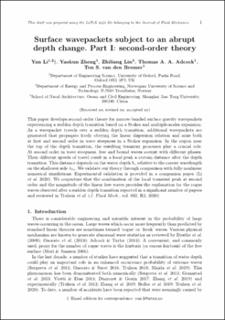| dc.contributor.author | Li, Yan | |
| dc.contributor.author | Zheng, Yaokun | |
| dc.contributor.author | Lin, Zhiliang | |
| dc.contributor.author | Adcock, Thomas A.A. | |
| dc.contributor.author | van den Bremer, Ton S. | |
| dc.date.accessioned | 2021-03-22T10:11:52Z | |
| dc.date.available | 2021-03-22T10:11:52Z | |
| dc.date.created | 2021-02-21T13:05:07Z | |
| dc.date.issued | 2021 | |
| dc.identifier.issn | 0022-1120 | |
| dc.identifier.uri | https://hdl.handle.net/11250/2734754 | |
| dc.description.abstract | This paper develops second-order theory for narrow-banded surface gravity wavepackets experiencing a sudden depth transition based on a Stokes and multiple-scales expansion. As a wavepacket travels over a sudden depth transition, additional wavepackets are generated that propagate freely obeying the linear dispersion relation and arise at both first and second order in wave steepness in a Stokes expansion. In the region near the top of the depth transition, the resulting transient processes play a crucial role. At second order in wave steepness, free and bound waves coexist with different phases. Their different speeds of travel result in a local peak a certain distance after the depth transition. This distance depends on the water depth hs relative to the carrier wavelength on the shallower side λ0s. We validate our theory through comparison with fully nonlinear numerical simulations. Experimental validation is provided in a companion paper (Li et al, J. Fluid Mech., 2021, 915, A72). We conjecture that the combination of the local transient peak at second order and the magnitude of the linear free waves provides the explanation for the rogue waves observed after a sudden depth transition reported in a significant number of papers and reviewed in Trulsen etal (J. Fluid Mech., vol. 882, 2020, R2). | en_US |
| dc.language.iso | eng | en_US |
| dc.publisher | Cambridge University Press | en_US |
| dc.rights | Attribution-NonCommercial-NoDerivatives 4.0 Internasjonal | * |
| dc.rights.uri | http://creativecommons.org/licenses/by-nc-nd/4.0/deed.no | * |
| dc.title | Surface wavepackets subject to an abrupt depth change. Part 1. Second-order theory | en_US |
| dc.type | Peer reviewed | en_US |
| dc.type | Journal article | en_US |
| dc.description.version | acceptedVersion | en_US |
| dc.source.journal | Journal of Fluid Mechanics | en_US |
| dc.identifier.doi | 10.1017/jfm.2021.48 | |
| dc.identifier.cristin | 1892087 | |
| dc.description.localcode | © 2020. This is the authors’ accepted and refereed manuscript to the article. Locked until 19.9.2021 due to copyright restrictions. This manuscript version is made available under the CC-BY-NC-ND 4.0 license http://creativecommons.org/licenses/by-nc-nd/4.0/ | en_US |
| cristin.ispublished | false | |
| cristin.fulltext | postprint | |
| cristin.qualitycode | 2 | |

